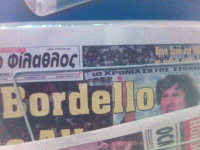Seeing is Believing?
A Problem in Stuart Hall’s ‘Encoding / Decoding’ – Model
(2002)
In his paper ‘Encoding / Decoding’ (1986/1973), Stuart Hall proposed the most influential model in media studies in the last few decades. As an attempted synthesis, this model combines semiological insights with Marxian theory; its purpose is to theoretically bridge the gap between media production, distribution and consumption. While Stuart Hall rightly emphasises that these different sites in the trajectory of the media message follow distinct logics, and different mechanisms are at work in any of them, the ‘encoding / decoding’ – model is able to describe the whole process of mass media communication; it thereby grasps a unity of contradictory phenomena. This distinguishes the model from collections of unconnected facts, and marks a decisive step from a descriptive to an analytical theory of communication.
The question, who can exercise power in the mass communication process and why, is of paramount importance for all audience research. In ‘Encoding / Decoding’, Stuart Hall tries to think determination and freedom in one model, to delineate the boundaries of interpretative freedom. The two ‘metaphors’ he employs for this stem from linguistics and semiology: code and reading. Hall distinguishes between the producer’s and the consumer’s code, and identifies three reading positions, the preferred, negotiated and oppositional. However, the status of these notions is somewhat unclear. Where are they to be found: in the minds of the subjects involved? In the text under scrutiny? Are these notions analytic, or do we have to construct them inductively, i.e. empirically from interviews and experiments? Finally, the term ‘code’ traditionally connotes a binding system with obligatory elements and structures. Does it, therefore, make sense to describe ideological media messages as codes, given that they are very complex ‘signs’, and in a certain way characterised by creative innovation?
But another problem is even more troubling. Graham Murdock criticises the model’s ”overemphasis on the rational dimension of response” (1989: 237), and Hall’s classic text in fact has a strong bias against the emotive: ”The ‘object’ of these (decoding) practices is meanings and practices” (1986: 127), not pleasures. However, references to non-cognitive processes can be found in the text, for Hall clearly talks about normative judgements, of approval. This results in a blurred notion of what decoding actually means.
We need to be sensitive to the difference between, say, a person not understanding the relationship between inflation and unemployment claimed in a news report, and, say, a person disagreeing with the claim (Corner 2000: 300; his italics).
To give another example: we can easily imagine a reader decoding a news report about violence occurring during a public demonstration meaningfully, while rejecting the preferred reading that the demonstrators are to blame. Instead he attributes the incident to, say, police provocation. Was this a misunderstanding? Or a critique of the message from a meta-level? How can we describe this decoding as oppositional if the ‘factual content’ is not challenged by the decoder? The ‘encoding / decoding’ – model contains no clear distinction between comprehension and agreement (Morley 1981: 3-5).
This, however, is not due to an arbitrary decision of the theoretician. As we shall see, there is an unavoidable relationship between understanding a message, and evaluating it as credible. In what follows I attempt a taxonomy of the possible connections which will hopefully enhance our understanding of the ability of texts to ‘prefer’ certain meanings. I focus on the decoding of news programmes, and move from the micro to the macro level. If comprehension and agreement are intertwined, how do they influence each other in the media consumption of ”news / documentary / current affairs” (6)?
Given the present hegemony of ‘active audience’-approaches, it seems apt to focus on processes and structures that determine decoding. Ien Ang rightly criticises that
the politics of reception analysis has all too often been one-sidedly cast within the terms of a liberal defence of popular culture, just as uses and gratifications research could implicitly or explicitly, in theoretical and political terms, serve as a decontextualized defence of the media status quo by pointing to their functions for the active audience (1996: 242-3).
I am thinking of John Fiske’s seminal text on television viewing, in which he first dissolves the TV audience in single viewers, and then these single viewers in multiple viewing subjects (1989: 57-59). In this secular utopia, determining moments in media consumption no longer play a decisive role. Critical audience research, on the contrary, has to theorise how audience activity can be channelled. I will argue that the emotive dimension in decoding is salient to understand dominance in mass communication. To explain this dimension, I draw on literary theory concepts developed by Wolfgang Iser. If modified, Iser’s notions of ‘implied readers / authors’ and ‘addressee / addresser’, can be employed instructively. This will shed a rather different light on pleasures arising from news consumption.
The following remarks are preliminary, and, in a certain way, speculative. They should be further discussed, and, where possible, empirically verified.


Understanding is believing?
With a polemical edge against the ‘uses and gratifications’-tradition, Hall writes that
Before this message can have an ‘effect’ (however defined), satisfy a ‘need’ or be put to a ‘use’, it must first be appropriated as a meaningful discourse and be meaningfully decoded. It is this set of decoded meanings which ‘have an effect,’ influence, entertain, instruct or persuade, with very complex perceptual cognitive emotional, ideological or behavioural consequences (Hall 1986: 130).
Pleasure possibly arises, in the next step, from the ”social practices” of decoding. Does that mean that decoding consists of a sequence of two different practices, a temporal order that could even be experimentally verified? Then, audience members would understand the denotative level of the text first, and decide in which mode to read it afterwards. But when ends the first part of the audience members’ activity: after their reading of the whole text? After one paragraph? How long is the first phase before they engage in evaluation?
Obviously, a sequential, i.e. temporal model of interpretative activity, with a phase of evaluation following comprehension, is not realistic. ”It is very possible for an individual or a group at one moment to decode in what I call ‘the hegemonic codes’ and at another moment to use oppositional codes” writes Hall (1994: 255-6). In a certain sense, interpretation takes place for every ‘sem’, every single meaning-carrying unit. Their systematic arrangement in the text allows for ever more new arrangements and connections, with the corollary that the conclusions we arrive at are always only tentative.
”The notion of decoding may well blur together a number of processes that would better be analysed be separately” (Morley 1983: 1881). Described in vernacular terms, reading makes the audience members
AGREE - MISUNDERSTAND
DISAGREE - UNDERSTAND
These verbs allude to the procedural character of reading. As we have seen, the corresponding processes and mental states cannot be theorised temporally. Rather these terms mark the poles which limit ‘a field’ where interpretation takes pace. Numerous proverbs and fixed expressions hint at the real connection between the cognitive and the emotional (‘love and understanding’). A person might describe the end of his relationship with a sentence like ‘We didn’t understand each other anymore!’ The distinction between emotive and cognitive reactions is valid only on an analytical level, in order to explain audience reactions theoretically. In discursive practice, these reactions are intertwined, and we encounter complex interactions between them.
John Corner rightly criticises the ambiguity in ‘encoding / decoding’:
We need to be sensitive to the way in which evaluative dispositions affective selective attention and interact with the matter of what is ‘understood’, ‘misunderstood’... and what is not understood at all (Corner 2000: 300).
If we denominate a specific decoding practice as ‘oppositional’, how can the relation between the cognitive, normative and emotive be described? As Roman Jakobson has shown, different functions of language are intertwined in every speech act (1990: 72-4). The question then becomes which of them is in the foreground. If the main function of an utterance is the contact between sender and receiver ‘as such’, Jakobson labels it phatic. The evaluation of the contact between the communicating subjects tests the reliability of the ”physical channel” as well as the ”psychological connection” (73). But in the mass media system, these tests cannot be carried out in a way comparable to face-to-face communication. Both sides make assumptions about the other side, but these are more difficult, in many instances impossible, to verify.
Usually the connection between comprehension and evaluation is theorised as a distortion of the denotative, referential function because of a preponderance of either expressive functions (with the main focus on the addresser) or persuasive and imperative functions (main focus on the addressee). But the relation between the different functions of language is not necessarily contradictory, but can be mutually supportive. Communication may well be most effective when all language functions are in accordance, and support each other. Moreover, in the case of a media commodity ‘phatic contact’ (Jakobson) has been made before the actual encounter takes place: it was bought, i.e. the audience member exercised a choice on the marketplace, with specific expectations.
An amount of psychological work (especially from learning psychology) has stressed that the dimensions of emotion and rationality cannot be isolated from each other. Massively oversimplifying, we can say that disapproval lowers attention, not so much concerning the experiencing of stimuli, but their later processing (Wells / Matthews 1994: 117). Insofar, oppositional decoding is more likely to miss denotative meanings. But there also exists a countervailing force: he or she who reads oppositional is aware of contradicting the preferred code. In this respect, oppositional readers do not understand less, but more. Their effort to decode is greater, for they need to reject some parts of the text while embracing others.
In his analysis of audience reactions to the BBC programme Nationwide, David Morley found that only two groups in fact rejected the whole framework of the presentation: ”West Indian women students, with a working class background” from inner city London (Morley / Brunsdon 1999: 209), and ”mainly white, male and female shop stewards and union activists with upper working class backgrounds” (234). The relation between understanding and agreeing is different between these groups: the first did hardly engage with the presented discourse, which they saw as irrelevant. The second acknowledged the discourses’ relevance, but offered a quite sophisticated meta-critique of the presentation (239). But interestingly, meta-critique, if less ‘eloquent’, can be found in the first group as well (196, 211), even though attention in this group was lower, and factual mistakes more frequent.
On a certain level, oppositional decoding practices are consciously rebellions, for media consumers identify the preferred code before they reject it. Stuart Hall described their attitude instructively with the sentence ”You wanted me to read it in this way, but I don’t read it in this way” (1994: 266). Such decided a rejection must be justified. What Herbert Marcuse called ‘the normative power of the factual’ is at work in media consumption insofar as the signifying power of the media institutions is naturalised, and usually not challenged. We have to understand that, for theoretical cogent reasons, pleasure arising from oppositional decoding is the exception. This assertion may sound bold. I want to return to this point later, and argue that usually a preferred reading is more pleasurable. This is because the corresponding subject position is less difficult to maintain, especially if consumption takes place alone.


Agency in and the theoretical status of ‘Encoding / Decoding’
Stuart Hall integrated different traditions in his model, and not all of them are easily compatible. In some sense, ‘Encoding / Decoding’ is a Marxist critique of the liberal ‘uses and gratifications’ tradition that draws heavily on the structuralism of Louis Althusser. This foundation results in a specific concept of subjectivity:
In the ordinary use of the term, subject in fact means: (1) a free subjectivity, a centre of initiatives, author of and responsible for its actions; (2) a subjected being, who submits to a higher authority, and is therefore stripped of all freedom accepting his submission… There are no subjects except by and for their subjection (Althusser 1993/1970: 56; his italics).
When ‘Encoding / Decoding’ emerged in the 1970s, this was, and still largely is, received wisdom in cultural studies. Paul Willemen, writing in Screen, represents a structuralist psychoanalytic critique of subjectivity. He describes the interaction of text and subject as a simultaneous and reciprocal process.
Neither do texts construct subjects outside of social processes then to be placed in those formations… But with texts too, there is a necessary simultaneity, a subject construction always already in history (1978: 45).
To read and understand means to become a subject, to be ‘interpellated’ by the text, as Althusser famously put it (1993: 45). The encounter of an individual and the text gives rise to a subjectivity that did not exist previously, which is theorised as a seemingly frictionless process.
The problem then becomes how to theorise agency. Much of the allure of structuralist approaches stems from their ostensibly scientific character. Even though of paramount importance, nothing is more difficult to theorise than subjectivity. If the subject is granted agency and initiative, its future behaviour is unpredictable; by definition, it cannot be extrapolated from past behaviour. This problem returns in cultural studies, where subjectivity delineates authority in individual meaning production. This production contains a moments of creativity, something the culture and media industries cannot get rid off. For Althusser and his disciples, however, exactly the notion of subjectivity is the core of ideology, and agency a mere illusion. And if this is true, we can rightly limit our inquiry to the textual level.
The epistemological problems of structuralism increasingly troubled Stuart Hall himself (1994: 255). Using the distinction between ‘structure’ and ‘practice’, the theoretician has pointed out that
Practice is how a structure is actively reproduced. Nevertheless, we need both terms if we are to avoid the trap of treating history as nothing than the outcome of an internally self-propelling structuralist machine (Hall 1996: 15).
Notwithstanding Hall’s own reservations, his terminology in ‘encoding / decoding’ clearly is structuralist. This results in conceptual difficulties. The employment of the concept ‘code’, for example, means ”taking for granted high levels of systemic organisation among cultural phenomena, levels often involving a fixity of relationships” (Corner 1980: 84). This is problematic for encoding. Two different ‘codes’ are at work in media signification: the general social signifying practice and the secondary ”code of professionalism” that reproduces ”the hegemonic signification of events” (Hall 1986: 136). The elements of the professional code, especially in the production of news television, could also be described as ideological tropes. If we decide to call these tropes ‘signs’, we need to stress their complexity.
However, ‘code’ is also problematic for the side of decoding. Stuart Hall stresses that the line between denotative and connotative meaning is far from clear (132-3). It is rather a question of the scope of possible interpretations how much power the text and how much power the reader can exercise, i.e. the obligation to connect a specific signifier with a specific signified. When denotation and connotation are seamlessly interwoven, a totalitarian rule of meaning reigns supreme. To decode a certain ‘sign’ automatically denotative and connotative in the preferred (and then rightly expected) fashion truly means the end of subjectivity. Empirical research as well as everyday experience, however, show that this is not the case. That audiences reactions are far from predictable is the eternal problem of the culture industry. Hall calls his distinction between denotation and connotation an analytical one, which he supposedly uses only for reasons of convenience. The distinction describes levels of the same process of social signification. What engenders this difference, however, is not sufficiently explained (and, as I would argue, not explainable with structuralist concepts).
All this results in a problematic theoretical status of some of the model’s elements. When Hall describes ”operating inside the dominant code” as ”the ideal-typical case” (Hall 1986: 136), he implicitly allocates this notion an analytical status. The different codes of reading clearly are abstractions, ideal types that allow theoreticians to make connections between previously unrelated phenomena in order to describe underlying structures.
Is the preferred reading a property of the text per se? Or is it something that can be generated from the text (by a ‘skilled reading’) via certain specifiable procedures? Or is the preferred reading that reading which the analyst is predicting that
most members of the audience will produce from the text? In short, is the preferred reading a property of the text, the analyst or the audience? (Morley 1992: 57)
It seems to me that these questions can not be resolved without taking into account intentionality. By definition, communication is inter-subjective, the encounter of different subjects, something Hall implicitly accepts when he says that encoding and decoding are ”different but interrelated practices” (Hall 1994: 257). An interrelation can only exist via a text that relates agencies outside of it.
Does all this necessitate a return to the (rightly unfashionable) notion of ‘the author’s intention’? How can the communicative encounter taking place in the field of the mass media be theorised? I will argue that the ‘encoding / decoding’ - model can be adjusted to theorise agency by taking on board concepts from literary studies.


Subject positions inside and outside the text
In the analysis of discursive formations, Graham Murdock, following Umberto Eco, suggests to distinguish between open and closed texts.
Closed texts have two main features. First, the discourses they work with are arranged in a distinct and well-signposted hierarchy so that one is preferred over the others and presented to the audience as truer (sic!) and more valid. This does not mean that it goes uncontested, simply that the contest is rigged. The ensuing struggle is resolved by the second main feature of the closed text, the unambiguous ending in which the superiority claims of the preferred discourse are demonstrated beyond reasonable doubt (1989: 240).
The sequential organisation of discourses mentioned above is only one method to close texts, to prefer. One of the methods with which producers try to enhance the ”effectiveness” of ”their” message (Hall 1986: 135) is the choice of perspective. As is well known in literary studies, the joy of narratives lies in their evoking a vicarious subjectivity, in identification. This was traditionally theorised as ‘point of view’ and ‘implied reader’, i.e. the concept an author has of readership.
Heavily inspired by Jacques Lacan, Paul Willemen criticises this notion. For him it necessitates ”full subjects having a point of view and even imposing it on others” (1978: 48). While it could seem as if he thereby privileges the text, on the other hand, he criticises the idea of textual structures dominating subjectivity: ”This split (between textually implied and subjects in history) makes texts into autonomous, self-enclosed and self-regulating systems available for appropriation by ‘objective’ structural analysis” (49). One of the many problems of this ”abstract text-subject relation” (Morley 1986: 163) is that the reader appears to be a blank page, as if bringing nothing with him or her to the interpretative act. Every text evokes ‘its’ subjects. Every subjectivity is hailed by only one text, not even by intertextual structures (which is how ideology is classically understood). Instead of an encounter of reader and text, one subdues the other, ”there can be no struggle at the site of the interface between subject and text” (164).
It is not helpful to understand the complexities of the relationship between text and reader to collapse subject positions inside and outside the textual. It is more instructive to think of textual subjectivities as ‘offers’ a text can make, and to analyse the reactions of readers to these ‘offers’. Althusser likens the positioning of a subject in discourse to someone walking down a street, suddenly hearing his or her name. But does this hail really result in the immediate and unresisting knowledge ”Yes, that’s me!”? Calls can be ignored, or overheard, as we have seen in the case of oppositional readings in the Nationwide research project: the subject position offered by the television programme clearly did not appeal to some of the respondents.
When cultural students actually ‘go into the field’, that is take the effort to actually speak with audience members, they are often quite surprised. What Willemen calls a ”paranoid game” – ”The author inscribes readers at the point of reception, readers produce authors at the points of origin” (49) – is verifiable social practice of media production. The tradition of ‘gatekeeper research’ has shown the importance of the implied audience. Even though ”journalists typically know very little about their audience” (Schudson 2000: 152), they constantly construct a picture of the consumer of their product. It is of minor importance if their construction is realistic; it effects their practice. Listen to the following outbreak of the editor of the Sun during the 1980s, Kevin MacKenzie:
‘You just don’t understand the readers, do you, eh?’ MacKenzie rapped out his picture of the Sun’s older reader. ‘He’s the bloke you see in the pub – a right old fascist, wants to send the wogs back, buy his poxy council house, he’s afraid of the unions, of the Russians, hates the queers and weirdoes and drug dealers. He doesn’t want to hear about that stuff!’ he finally yelled, veins bulging.... (Chippindale and Horrie 1992: 147-8).
At every step of the communicative chain, subjects make assumptions about the next step. Because media commodities are produced for a market under circumstances of competition, media producers structure the text in a way that might appeal to the readers they imply. Thus we can find marks of their intentions, identify textual features that allows as to re-construct the producer’s construction.
We will return to this point shortly. For the moment it is important too stress the different impact of the constructions of producers and consumers. Communication is the moment where different subjectivities meet, and this encounter leaves no side unchanged. But in the sphere of mass media, the encounter is not symmetrical. Media producers can influence the subjectivity of audience members, but these usually influence the producers only in the binary code at their disposal: to buy or not to buy. Stuart Hall theorises encoding and decoding as parallel, if asymmetrical. However, both corresponding practices are fundamentally different: ”Encoding is a signifying practice selecting and interpreting the whole world of signifiers, while decoding negotiates with an exclusively televisual object” (Lewis 1983: 179).


Ideal authors and implied readers
Justin Lewis rightly warns against ”conflating the textual subject and the real subject” (1983: 183). The textual subject is positioned in and by the text, with different, though sometimes overlapping strategies: in literature, it is produced by the ‘I’ of the narrative, in film by the positioning of the camera (the ‘point of view’). Most importantly for the subject positions in news reports are strategies which construct ”subject positions in relation to a preferred reading” (184). Lewis believes that the task of media analyst is ”to construct preferred readings after interviewing has taken place” (195). Then, however, preferring is carried out by the audience, which runs the risk of falling prey again to the revisionist perspective where the audiences’ activity does not encounter resistance.
Following Wolfgang Iser (1978), the subject positions at work can be further specified:
ADDRESSEE / ADDRESSER
MEDIA PRODUCER - IMPLIED READER IMPLIED AUTHOR - CONSUMER
(field of encoding) (text) (field of decoding)
This model shows an ideal-typical organisation of subject positions, with important methodological implications. The implied readers and authors are features of the subjects in the fields of encoding and decoding, whereas the concepts in the middle are properties of the text. As the reified product of (creative) work, the text gains a certain independence from the two social practices. Using ‘a skilled reading’, with which we inaugurate a hermeneutic dynamic between text and interpretation, we can construct these positions from the text, which in turn means, deductively.
There is no denying that the scholarly constructions ‘addressee’ and ‘addresser’ will inevitably be prone to the difficulties of hermeneutics. As such, they cannot tell us anything about actual audience behaviour which only can be theorised drawing on empirical findings, and inductively. But these constructs will enable us to understand better which individuals and groups are likely to take on the addressee’s position, which are not, and why they do so. Empirical research needs to find ways of describing the textual structures as exactly as possible (which includes finding the text’s ambiguities, its ‘holes’), and by the same token observing the meaning production of audiences without itself preferring certain reactions. This avoids collapsing textual subjects and subjects in history, and instead turns to an analysis of their interactions, and the gap between them (as a social critique of mass media communication).
The distinction between reader and addressee on the one hand, and between author and addresser is decisive. As a more detailed model of subject positions in the communication process, it allows to think more exactly about the reading positions that Stuart Hall labelled preferred, negotiated and oppositional. The boundary between these positions is far from clear-cut, and their distinction rather concerns different levels, slight nuances and hidden ambiguities. In the everyday practices of media consumption, full-blown rejection is as rare as unconditional belief, and ”negotiated reading are probably what most of us do most of the time” (Hall 1994: 265).
The addressees arising from, say, a journalist’s constructions, is one of the ”indicative signifiers which try to imprint inside the message itself in which way it could be decoded” that Stuart Hall talks about, one of the ”textual moments that determine meaning” (1996: 26). But meaning must be taken, that is, the subject positions available in the text must have a sustained effect if behaviour and opinion is to be altered. To make the addressee attractive for identification means to make ‘an offer that cannot be rejected’. It is part of the preferring a certain meaning.
In the ideal type of a preferred reading, two of the above subject positions do not come into play: the ‘addresser’ and the ‘implied author’. As we have seen, even negotiating the message needs to be justified. it means that empirical readers do not take the position of the addressee, whereby a certain disharmony between him the implied author arises. Readers engage with authors if they starts to appear ‘unreliable’. Pleasure, in the sense of meeting the least resistance and therefore minimising effort, arises from an unproblematic identification with the addressee (Willemen’s ‘textual subject’). While this may be unproblematic in most instances in fictional texts (characterised by a different type of truth claims), identification in the news is politically highly problematic, as I will argue later.
The French philosopher Maurice Merleau-Ponty was of an impressive optimism about the interpersonal possibilities of communication: ”After reading, listening it is possible to say: in this light at least I have been you!” (quoted in Craib 1998: 39) To a certain extent, Wolfgang Iser follows this position in his description of the ‘textual encounter’:
(Texts) consist of ideas throughout by someone else, but in reading the reader becomes the subject that does the thinking. Thus there the disappears the subject-object division that otherwise is a prerequisite of all knowledge and observation (1978: 292).
Interestingly, Iser believes that identification can only happen under two premises: ”the life-story of the author must be shut out of the work and the individual dispositions of the readers must be shut out of the act of reading” (1978: 292-3). If not a certain ‘space’ is opened where the merging of addressee and reader can take place, the existing difference between author and reader comes into focus.


Addressee and Addresser in the News
The concepts developed above have to be adjusted to become instructive for audience research. Why is an oppositional position rather uncomfortable, and reading against the grain exhausting? It is not realistic to limit the notion of implied authors to one specific journalist producing the piece, moreover this journalist is rarely known. Developed media commodities are the product of a specific division of labour, and the whole institution is granted authority. In normal circumstances, addresser and implied author are of no importance because the functioning of the media system is naturalised. In a certain way the intertextuality of news exacerbates the reader’s position, insofar a reading position is forced to uncomfortably reject the truth claims of a specific media either radically – which means allowing doubts of ontological dimensions – or attributing the unreliability of the message to specific distortions. This points to the paramount importance of cumulative effects through which certain reading positions are ‘trained’ over a longer period of time. For obvious reasons, such effects cannot be observed in tests concerning single media products.
The subjectivity hailed by the addressee in the text allows for certain pleasures. What, then, are the generic features of the addressee in news reporting? David Morley notes that ”current affairs television presumes, or requires, a viewer competent in the codes of parliamentary democracy and economies” (Morley 1981: 12). Not only has the viewer to know about the corresponding procedures, but must also take interest in them. He or she ‘listens to both sides of the story’.
Dominant definitions connect events, implicitly or explicitly, to grand totalizations, to the great syntagmatic views-of-the-world: they take ‘large vies’ on the issue: they relate events to the ‘national interest’ or to the level of geo-politics, even if they make these connections in truncated, inverted or mystified ways (Hall 1986: 137).
The addressee appears as a subject that forgoes its particular interests. The same is true for the addresser, whose truth claims are ubiquitous, but discrete and barely perceivable. What is described as neutrality and objectivity of news is exactly the avoidance of socially specifiable subject positions, with important effects. Tony Bennett notes about news programmes that they ”achieve their ideological effectivity precisely through their observation of the statutory requirements of balance and impartiality” (quoted in Schudson 2000: 144).
Negotiated reading, on the contrary, means to argue with the exception: this particular war, asylum-seeker, factory, or street. The preferred reading position is one of rationality, with the most important criterion being practical feasibility, the ‘how’ and ‘what’, not the ‘why’. I would argue that a lot of the attraction this rational addressee can exercise is offering a way of banning the fears that arise from a society characterised by periodic crisis, general unpredictability and competition.


Ritual Functions in the Mass Communication
It was a common preconception that news broadcasts by definition fulfil predominantly denotative functions, and privilege the cognitive. Only slowly the phatic needs and strivings of audiences come into focus. In Nordenstreng’s research on Finnish television audiences for example, the cognitive effects on the majority of viewers were minimal.
His research showed, that while 80 per cent of Finns watched at least one news broadcast per day, when interviewed the next day they could remember hardly anything of the specific information given by the news (Morley / Brunsdon 1999: 122).
Contrary to the conclusions of Nordenstreng, who describes this specific way of consuming as a ‘mere ritual’ which has ‘no effect’, the ritual function of media consumption is of paramount importance. His research has to be situated within the specific historic situation in a specific region of the world. In the news, readers and viewers are explained ‘what is going on in the world’. But the importance of their understanding, their opinions and consent is far from clear, for they rarely influence the workings of the societal macro level. For many, media consumption is a possibility of linking the micro with the macro level, a way of making sense of their life in a ritual way. The specific content, albeit not exchangeable, is of lesser interest than the consumption of ‘news as such’.
The divide between public and private is characteristic for modern capitalist societies, and is for example reflected in the specific narrative structure of television news: the welcome of the presenter(s), domestic and foreign news, culture, sport, the weather. This sequence remains stable whatever events are reported. This narrative organisation of the broadcast serves the ritual function and clearly exceeds the formal (Silverstone 1994: 11-23). Compare also the respective organisation of newspapers in politics, culture, sport, miscellaneous, which has undergone only minor changes since the emergence of ‘print capitalism’ (Anderson 1983: 46-9).
When the ritual function of media consumption prevails, informative needs of audience are either low, or satisfied in other ways. Crudely put, under social circumstances characterised by stability and predictability, audiences need not care for specific contents. The split between seemingly unconnected spheres of the social, the economic and the political, which is characteristic for capitalist societies, allows for the production of a ‘phantasmagoric’ separation between the public and the private. Media consumption then serves as a ‘boundary-maintaining mechanism’ (Talcott Parsons) between the home and the outside, the former being the site of the family / the familiar, allegedly concrete and secure with high emotional investments, and the latter abstract, strange and remote (Lull 1990). Paradoxically, the consumption of information can then produce a pleasurable distance.
It is this distance that allows for media self-reflexivity, and the various pleasures of semiotic surfing (cf. Fiske 1989: 59). Ritual news consumption is possible in a social situation where the workings of the economy and politics are frequently perceived to be of little interest, for they putatively cannot be influenced. John Thompson allocates the events on the TV screen ”refractory character” (1995: 228). This is true not only for the representation and mediation, but for the events as such. Compare Jostein Gripsrud’s instructive remark about tabloid newspapers: ”These papers seem to have responded to a widespread feeling amongst the people that they do not need politically relevant information – for they were not really taking part in politically processes” (1992: 93). This nevertheless changes in situations of crises, when audiences start making direct connections between everyday practice and media texts. In general, reflection theories guide the attitude of recipients whenever such connections are possible. No one approaches weather forecasts and the latest from the stock markets as pleasurable constructions.
Conclusions
The ambiguity of Hall’s notion of decoding, involving both emotional and cognitive practices, is not coincidental, but reflects that both dimensions are intertwined, if in a complex and sometimes contradictory way. To read oppositional may in some instances lead to lower attention, but usually involves drawing on a meta-level. In the terminology of Jakobson, this means to privilege the denotative function, while neglecting the emotive.
Some of Hall’s structuralist terminology complicates matters, for this can hardly be reconciled with empirical reading practices of subjects outside the text. However, Wolfgang Iser’s distinction between addresser and implied author on the one side, addressee and implied reader on the other, allows us to understand better the complexities of news consumption – which is after all an interaction. The preferred subject position offered by the text – the addressee – is one of the textual features that ‘close’ texts. Oppositional decoding is uncomfortable decoding: it not only requires greater efforts, but fails to satisfy the phatic needs of consumers. This is why individuals likely to operate within an oppositional code will not engage with a text in the first place, which simply means not buy or watch it. The ritual dimension of news consumption is of great importance, because it reflects the factual separation of everyday life from the political and economic mechanisms.
The interplay of decoders and the subject positions a text can offer needs to be further analysed. However, we should not overestimate the freedom that people can exercise while negotiating with media texts. The question who can exercise power in the mass communication process and why is as inevitable as unsolvable in an a-historical way. I fear that the question how texts generally work may well be unsolvable. It seems to me that the more interesting, and solvable, question is which specific subjectivities are likely to resist specific texts, and why.
Literatur
Louis Althusser (1993): Essays on Ideology. London: Verso.
Benedict Anderson (1983): Imagined Communities. Reflections on the Origins and Spread of Nationalism. London: Verso. Ien Ang (1996): Culture and Communication. Towards an Ethnographic Critique of Media Consumption in the Transnational Media System. In: John Storey (ed.): What is Cultural Studies? A Reader. London: Arnold. 237 – 253. Derek Bousé (2001): Film Theory and Bogus Theory. In: Greg Philo / David Miller (eds.): Market Killing. What the Free Market Does and what Social Scientists can do about it. Harlow, England: Longman. Peter Chippindale / Chris Horrie (1992): Stick In Up Your Punter! The Rise and Fall of The Sun. London: Mandarin. John Corner (2000): Reappraising Reception. Aims Concepts and Methods. In: James Curran / Michael Gurevitch (eds.): Mass Media and Society. London: Arnold. 280 – 303. John Corner (1980): Codes and Cultural Analysis. In: Media, Culture and Society No. 2. 73 – 86. Ian Craib (1998): Experiencing Identity. London: Sage. Jon Cruz / Justin Lewis (1994): Viewing, Reading, Listening. Audiences and Cultural Reception. Boulder, Colorado: Westview. James Curran / Michael Gurevitch (2000): Mass Media and Society. London: Arnold. James Curran / David Morley / Valerine Walkerdine (1996): Cultural Studies and Communications. A Reader. New York: Arnold. Peter Dahlgren / Colin Sparks (1992): Journalism and Popular Culture. London: Sage. Brenda Dervin et al. (1989): Rethinking Communication. (Volume 2) London: Sage. John Fiske (1989): Moments of Television. Neither the Text nor the Audience. In: Ellen Seiter et al. (eds.): Remote Control. London: Routledge. 56 – 78. Nicholas Garnham (2000): On the Cultural Industries. In: James Curran / Michael Gurevitch (eds.): Mass Media and Society. London: Arnold. 78 – 83. Jostein Gripsrud (1992): The Aesthetics and Politics of Melodrama. In: Peter Dahlgren / Colin Sparks (eds.): Journalism and Popular Culture. London: Sage. 285 – 300. Larry Gross (1989): Out of the Mainstream. Sexual Minorities and the Mass Media. In: Seiter et al. (eds.): Remote Control. London: Routledge. Stuart Hall (1986): Encoding / Decoding. In: Stuart Hall / Andre Lowe / Paul Willis (eds.): Culture, Media, Language. Working Papers in Cultural Studies, 1972-79. London: Hutchingson. 128 – 138. Stuart Hall / Andre Lowe / Paul Willis (1986b): Culture, Media, Language. Working Papers in Cultural Studies, 1972-79. London: Hutchingson. Stuart Hall (1994): Reflections upon the Encoding / Decoding Model. An Interview with Stuart Hall. In: Jon Cruz / Justin Lewis (eds.): Viewing, Reading, Listening. Audiences and Cultural Reception. Boulder, Colorado: Westview. Stuart Hall (1996): Signification, Representation, Ideology. Althusser and the Post-Structuralist Debates. In: James Curran / David Morley / Valerine Walkerdine (eds.): Cultural Studies and Communications. A Reader. New York: Arnold. 11 – 34. Wolfgang Iser (1978): The Implied Reader. Patterns of Communication in Prose Fiction. London: John Hopkins. Roman Jakobson (1990): On Language. Edited by Linda R. Waugh and Monique Monville-Burston. Harvard University Press. Justin Lewis (1983): The Encoding / Decoding Model. Criticism and Redevelopment for Research on Decoding. In: Media, Culture and Society No. 5. 179 – 191. James Lull (1990): Inside Family Viewing. Ethnographic Research on Television’s Audiences. London: Routledge. David Morley (1981): ‘The Nationwide Audience’ – A Critical Postscript. In: Screen Education No, 39. 3 – 14. David Morley (1986): Texts, Readers, Subjects. In: Stuart Hall / Andre Lowe / Paul Willis (eds.): Culture, Media, Language. Working Papers in Cultural Studies, 1972-79. London: Hutchingson. 163 -173. David Morley (1992): Television, Audience and Cultural Studies. London: Routledge. David Morley / Charlotte Brunsdon (1999): The Nationwide Television Studies. (Research in Culture and Media Studies, Volume 6) London: Routledge. Graham Murdock (1989): Critical Inquiry and Audience Activity. In: Brenda Dervin et a. (eds.): Rethinking Communication. (Volume 2) London: Sage. 226 – 249. Greg Philo / David Miller (2001): Market Killing. What the Free Market Does and what Social Scientists can do about it. Harlow, England: Longman. Michael Schudson (2000): The Sociology of News Production Revisited. In: James Curran / Michael Gurevitch (eds.): Mass Media and Society. London: Arnold. 141 – 159. Ellen Seiter et al. (1989): Remote Control. London: Routledge. Roger Silverstone (1994): Television and Everyday Life. London: Routledge. John Storey (1996): What is Cultural Studies? A Reader. London: Arnold.John Thompson (1995): The Media and Modernity. A Social Theory of the Media. Cambridge and Oxford: Polity Press. Adrian Wells / Gerald Matthews (1994): Memory and Attention. A Clinical Perspective. Hove, United Kingdom: Lawrence Erlbaum Associates. Paul Willemen (1978): Notes on Subjectivity. On Reading Edward Branigan’s ‘Subjectivity Under Siege’. In: Screen No. 19. 41 – 69.